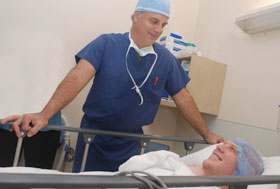  |
| HOME | THIS ISSUE | CALENDAR | GRANTS | BACK ISSUES | < BACK | NEXT > |
Orthopaedic surgeon offers new procedure for knee repairby Chris DeFrancesco - September 24, 2007 | ||||
| Dr. Robert Arciero, chief of the sports medicine division in the Department of Orthopaedic Surgery at the UConn Health Center, is one of a handful of orthopaedic surgeons in the country offering a new procedure for repairing the knee’s anterior cruciate ligament (ACL), called “double-bundle” reconstruction. It’s a procedure that has been analyzed and compared with traditional ACL surgery in Arciero’s lab. The traditional ACL repair, which surgeons have used for about 20 years, involves attaching a single graft to the thigh bone and shin bone. In most cases, this prevents abnormal shifting of the knee, enabling the patient to walk again and, in most cases, eventually resume athletic activity without pain. The double-bundle repair involves a second graft through a second tunnel between the bones, and better replicates the function of a natural ligament. “If we can get a graft that behaves like the normal one, then we have a much better chance of having that knee remain stable throughout the patient’s lifetime, and maybe protecting the knee from further damage,” Arciero says. In Arciero’s lab, researchers have measured the biomechanics of the ACL, comparing the normal ACL to a typical single-bundle reconstruction, and then measured it with double-bundle reconstruction. They found that with the double-bundle reconstruction, the knee behaves more like the normal knee. A potential added benefit for patients who undergo double-bundle reconstruction is that they may be less susceptible to arthritis in the surgically repaired knee. That’s something scientists will need to watch as double-bundle patients age, Arciero says. “If we can more closely replicate the normal knee, then at 20 or 30 years down the line, the knee will look like a normal knee, or, like it should,” he says. Translating science into therapies that can benefit patients is a growing emphasis in medical research, and it’s an area where the Health Center’s New England Musculoskeletal Institute excels.
“If you are going to move new therapies from the bench to the bedside, you need to have interaction between the scientists, who are developing new ideas and concepts and are working on them, and the surgeons who are going to implement them,” says Dr. Jay Lieberman, director of the Musculoskeletal Institute. The double-bundle ACL repair is one of the recent breakthrough procedures that has been analyzed in the Institute’s research labs. The Institute, one of the Health Center’s signature programs, is a consortium of services that includes orthopaedic surgery (sports medicine, joint replacement, foot and ankle, hand, and bone oncology), as well as centers for comprehensive spine care, rheumatology, osteoporosis, and dental implants. The analysis of ACL repair surgery is an example of translational research. “First, they evaluated the repair in the biomechanics lab, next they practiced the procedure in our bioskills laboratory, and now they are doing it clinically on patients,” says Lieberman. “Our ultimate goal with our basic science research is to develop new therapies for patients,” adds Lieberman, a total joint replacement surgeon who is also chairman of the Department of Orthopaedic Surgery. “These therapies may involve new molecules or surgical procedures. We have an interest in both bone grafting and soft tissue healing, and using stem cells to enhance healing. There are a number of investigators within the New England Musculoskeletal Institute who are experts in this area.” |
| ADVANCE HOME UCONN HOME |

